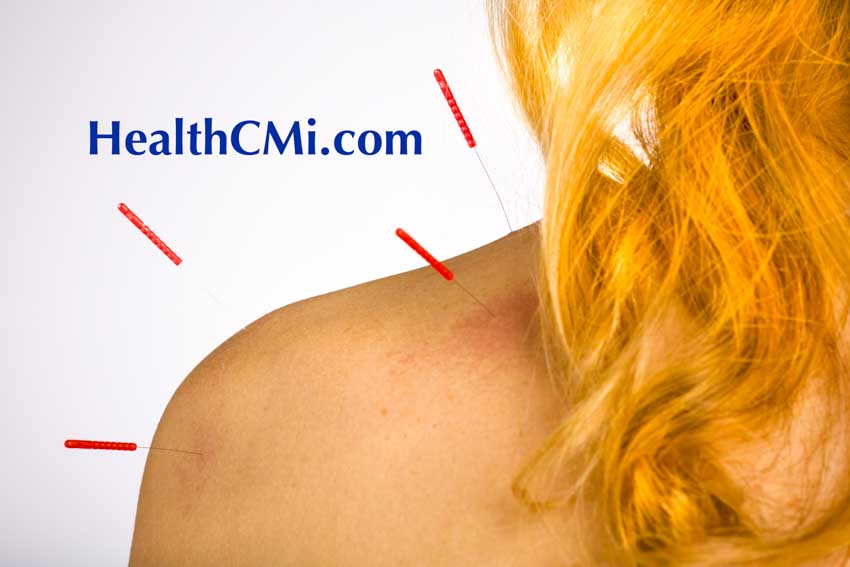Acupuncture is effective for relieving symptoms of scapulohumeral periarthritis. Researchers at the Hainan Hospital of Traditional Chinese Medicine conducted a clinical trial on the efficacy of acupuncture. The results show that range of motion exercises during acupuncture increase shoulder mobility and flexibility while reducing overall pain levels. [1]
Results were measured with a visual analogue scale (VAS) to assess pain level, patient strength to assess shoulder functioning, the Constant-Murley Score (CMS), the activities of daily life (ADL), and the range of motion (ROM). Higher CMS scores indicate higher shoulder function. VAS scores in the two study groups were similar at the beginning of the trial, but the acupuncture integrated group presented a more marked drop from 6.5 ±1.2 to 1.7 ±1.4. The integrated group also saw a more considerable improvement in CMS, increasing from 54.5 ±8.8 to 84.6 ±7.9. By contrast, the change in the control group was less significant, increasing from 53.3 ±10.3 to 75.7 ±9.9.
All 60 patients admitted into the study were 45–75 years old. In TCM principles, their symptoms are of the cold-dampness category. X-ray and other examinations demonstrated scapulohumeral periarthritis. Those with shoulder pain induced by a tumor, tuberculosis, rheumatic or rheumatoid shoulder arthritis, severe cardiovascular disease, liver or kidney insufficiency, malignant tumors, diabetes, hyperthyroidism, coagulation disorders, or history of radiotherapy were excluded. The patients included were randomized into an integrated group and a control group, with 30 cases in each group. There were no statistically significant differences in patients’ gender, age, or course of condition prior to the study. The control group received standard acupuncture and the integrated group had the addition of range of motion exercises during acupuncture treatments.
For the control group, needles (0.40 mm × 40 mm, Guyuan Medical Equipment Company) and moxa (12 mm × 15 mm, Nanyang Lvying Aicao Company) were used. The acupoints chosen were as follows:
- LI15 (Jianyu)
- TB14 (Jianliao)
- SI19 (Jianzhen)
- LI16 (Jugu)
- LI11 (Tianzong)
- TB13 (Naohui)
- LI14 (Binao)
- Jianqian (Extra, 肩前)
A lateral position on the healthy side was taken to expose the affected area. Needles were swiftly inserted. Then, needles were quickly manipulated obliquely to the left, right, up, and down respectively to form a 45-degree angle with the skin surface. Finally, needles were manipulated vertically to achieve a deqi sensation. Two moxa pieces were then attached to the needle ends. Treatment was administered on alternate days for 40 days.
For the integrated group, the same shoulder acupoints were used with the patient in a seated position. In addition, bilateral GB34 (Yanglingquan) also received needling treatment. A lifting, thrusting, swirling, and rotating method was applied to stimulate deqi. Upon deqi arrival, patients were advised to perform shoulder flexion, internal rotation, external rotation, and abduction. Range of movement was gradually increased to reach patients’ tolerance levels. Needles were manipulated every five minutes and retained for a total of ten minutes. Treatment was administered on alternate days for 40 days.
Researchers note that needling stimulation on the distal acupoints increases the levels of endogenous opioid peptides and inhibit the release and signaling of substance P when combined with range of motion exercises. The stimulation also raises patients’ pain thresholds and reduce physical and emotional responses to pain, resulting in pain relief. [2]
References:
[1] Wang Lijuan, Luo Heping, Ding Yi, Chen Lei, Zhang Haiying, Wang Yawei, Randomized Controlled Trial of Acupuncture Movement and Warm Round Sharp Needle, Acupuncture for Scapulohumeral Periarthritis of Wind Cold Dampness Pattern, Western Journal of Traditional Chinese Medicine,2021 Vol.34 No.7.
[2] Liu Shidan, Analysis on the effects of acupuncture combined with movement therapy in treatment of scapulahumeral periarthritis, Chinese New Clinical Medicine, 2013, April, Vol. 6, ISS 4.



